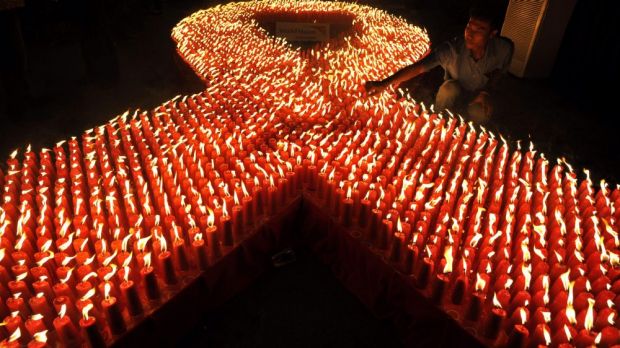One in five new HIV infections is acquired overseas, according to new figures, sparking a public health campaign targeting travellers both leaving and arriving in Australia.
New data from NSW Health shows that of the 354 people newly diagnosed, 21 per cent were likely to have acquired their HIV infection overseas and 64 per cent were infected in Australia. A further 15 per cent did not know where they were infected.
”It might be a risk people don’t perceive.”
Dr Josephine Lusk
Health experts are concerned at the high proportion of heterosexuals and older people who report being infected overseas.

Despite awareness of HIV through events such as World AIDS day, there were 354 new HIV infections in NSW in 2013, the latest data shows. Photo: AFP
Heterosexual contact accounts for 17 per cent of new HIV diagnoses in NSW. Of the heterosexual cases, more than half were acquired overseas.
Director of the Short Street Sexual Health Centre, Dr Josephine Lusk, said many holiday makers and business travellers do not see themselves as being at risk of HIV infection.
“Overseas acquisition is something we should be thinking about,” she said.
“It’s not just people who travel for holidays, we’re interested in getting this message to people who go overseas for work. It’s just a reminder about being safe while you’re overseas. It might be a risk people don’t perceive.”
Travellers leaving the country will see posters in Sydney Airport’s departures area urging them to be aware of the dangers of unsafe sex, sharing needles or tattooing using unsterilised equipment. Those returning will see posters prompting them to get tested if they engaged in risky activities overseas.
“One of the key issues with HIV is detecting it early so it is a reminder that if you have done any of those things, you should think about getting checked up,” Dr Lusk said.
Other infections such as syphilis, gonorrhoea, chlamydia and hepatitis B and C are more common overseas.
“Certainly STIs and HIV often go together,” Dr Lusk said. “If you are at risk of HIV you are most certainly at risk of another infection.”
There are 26,800 people living with HIV in Australia; 13,000 of whom are in NSW.
Chlamydia is the most prevalent notifiable disease with NSW Health data showing 5671 cases were reported in the second quarter of 2014. It was most common among females, older teenagers and young adults.
Gonorrhoea rates increased sharply in 2014 with second-quarter figures showing 1217 cases. Infectious syphilis has been rising since 2011, with 147 cases notified in the second quarter of 2014. NSW Health does not record where these infections were acquired.
Dr Lusk said even if travellers visit a country with low rates of HIV and other STIs, they should not be complacent.
“Even if they go to a country which doesn’t have high prevalence, they might go to a hotspot which does have high prevalence because everyone else is out there having a good time,” she said.
STATS:
New HIV infections in NSW residents: 354
Of the 354:
– 278 were men who have sex with men (MSM)
– 61 were from heterosexual contact
– 8 were injecting drug users
– 5 were from an unknown source
– 1 was mother-to-child transmission that occurred overseas
– 1 was acquired through an “other” exposure.
Of the 354:
– 225 were likely to have acquired HIV in Australia.
– 75 were likely to have acquired HIV overseas
– 54 acquired the infection in an unknown location.
Of the 61 heterosexual cases, 52 per cent were likely to be acquired overseas.
Of the 278 MSM cases, 15 per cent were likely to be acquired overseas.
Sources: NSW HIV 2013 Epidemiological Report; Health Protection NSW Communicable Diseases Branch Sexually Transmitted Infections.
